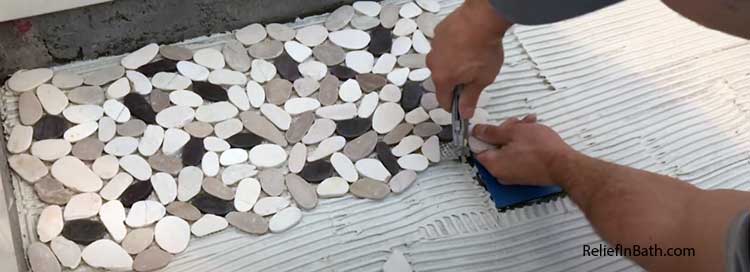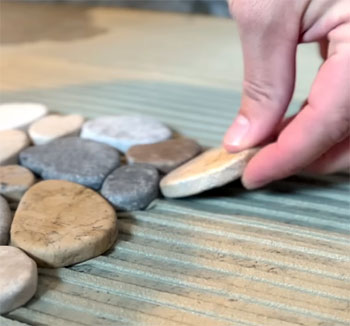Pebble shower floors are excellent in appearance and quite affordable to do when it comes to pebble shower floors. However, one of the issues you may face is the loose pebble shower floor.
This is where the pebbles start coming loose.
Here, I will go through why this happens with pebble shower floors. And I won’t just leave you with the reasons. I will also go through the solutions and fixes for this problem.
So, if you are facing this issue or planning on getting a pebble shower floor, this can be very helpful.
Now, without wasting any more time, let’s jump right into the whole thing.
Why Do Pebble Shower Floors Come Loose?

Several reasons can cause the pebble shower floor to come loose. But I won’t be going through them all as some of them are based on particular scenarios.
Instead, I will go through the reasons that can happen in general and happens more often. And keep in mind, this is a common problem on all River Rock shower floors.
One of the most crucial reasons for the pebble shower floor coming loose is improper sealing. When the pebble shower floor isn’t sealed correctly, it can penetrate water.
What happens there is that water goes into the floor and impacts the adhesive and or the mortar under the flooring. This results in loosening up the stones you used for the flooring.
This can also happen if there is a lack of grout in the installation. Remember, installing pebble shower floors requires more grouts than regular flooring.
So, if your flooring lacks grouts in it, then it’s most likely to come loose at some point.
Another reason for the pebble shower floor coming loose is the lack of maintenance. Pebble shower floors require a lot of maintenance compared to other floor types.
You have to make sure you are cleaning them properly. The wrong cleaning methods can wear out the grout and sealing. This later on results in loosening the pebbles on the flooring.
You also need to keep an eye on any kind of mold and mildew growth. As pebble shower floors can retain water especially, river rock floors, they are always at risk of mildew growth.
When that happens, it can quickly get in between the pebbles and then loosen the bond between them. This results in the whole floor coming loose.
Typically, these are the reasons that cause the pebble shower floors to come loose. However, you can easily prevent this from happening by avoiding these issues.
All you have to do is follow a proper installation method and regular maintenance.
Dangers of a Loose Pebble Floor
While a few loose pebbles here and there may not seem like a big deal, allowing the issue to persist can create some significant problems:
- Slip and Fall Hazard – As more and more pebbles become disconnected from the subsurface, they act like loose marbles underfoot. This can easily lead to slips and falls, especially on a wet surface. Loose pebbles make entering and exiting the shower particularly hazardous.
- Growth of Mold and Bacteria – When pebbles become detached, moisture is allowed to seep underneath and provide a prime environment for mold, mildew, and bacteria to grow. This can create very unsanitary shower conditions and potential health issues.
- Damage to Underlayer – Unattached pebbles will grind and move against the subsurface when stepped on. This can gradually erode and damage the waterproofing layers, adhesive footing, and subsurface itself.
- Spreading of Problem – Pebbles that are initially loose will begin to work against surrounding bonded pebbles. This can spread the problem rapidly across the entire floor, resulting in wide patches of loose, shifting pebbles.
- Inability to Reseal/Recoat – Attempting to reseal or recoat a pebble floor that has excessive loose pebbles will be ineffective. Any repair material will simply wash out from underneath detached pebbles with continued use.
Regular inspection and prompt attention at the first sign of looseness is highly recommended to avoid these risks.
How To Fix The Pebble Shower Floor?

Now you know why this happens and how you can prevent it. But what if the floors are already coming loose what to do then?
Don’t panic!
I am here to help you out with that as well. I have two different solutions that you can try to fix this problem. Let’s get through them one by one and see which suits your needs the best.
Method – 1: Removing And Reinstalling
Now, if you think the flooring installation is flawed or it’s too late to repair the whole flooring, then this is the method you should go for.
When most of the stones from your flooring have come loose, there is no other way than this one to fix the issue. Even though it will be expensive, you are left with no choice either.
So, let’s see how you can remove the pebble shower flooring on your bathroom. You can also hire professionals to do it; it’s up to you.
Removing Pebble Shower Floor
- First, you have to decide on the state of the stones. Whether you want new stones or you will keep the existing ones will have an impact on the cost. If the existing ones are usable, they will be a better option to minimize the cost.
- After that, you have to start with the removal of the grout. You can use a chisel along with a hammer to remove all the grout from the flooring. Or you can get more aggressive with other tools. Just consider the factor of using the stones. If you are not going to use the old stones, you can go with any method for removing grout.
- Once all the grout is off, you can start with removing the pebbles. To do that, you simply need to get the chisel under the pebbles and slowly pick them off. With the grout off, the pebbles should come out pretty easily. This can be a bit time-consuming because you have to get all the stones one by one.
- Next up, you have to remove all the mortar underneath the stones. Here, you have to be very careful not to damage the sub-floor underneath the mortar.
- Once you have removed everything, you will need to clean up all the debris and dust around that place. You can use a shop vac for that purpose.
- Finish off the removal process by ensuring that you have a clean and flat surface for the newer pebble floor installation.
As for the installation part, I highly recommend getting professional help for that purpose. Because installing pebble floors requires expertise over a lot of things.
Even you will need to know the correct measurement for the mortar mixture. So, it’s better to opt for professionals there, or you may end up with another faulty installation.
Method – 2: Repairing Pebble Shower Floor

Now, this is the solution you can pick when some of the pebbles have come loose from the flooring.
If the damage isn’t too much and you can still repair it, this is a very cost-effective way to fix the problem.
Here’s how you can fix the issue.
- First, you have to look for the places that need to be repaired. This means looking for the areas where the pebbles have ultimately come loose.
- Then, you have to remove the loose stones using a hammer and a chisel. Sometimes you may be able to remove them just by hand if they are too loose.
- Now, you have to get some waterproof sealant and use it in the areas you removed the stones from. You have to wait till the sealant has cured completely.
- After that, you have to either use an adhesive or a mortar in the affected areas.
- Then, you have to put stones in those areas to cover them up again. You can either use new rocks or use the older ones if they are usable.
- After placing the rocks, you have to use some grout to install the stones properly.
- They finish it off with another sealant coating as it suits the procedure.
That’s pretty much it for repairing the pebble shower floor. It’s not that difficult, and you can do it by yourself.
How to Prevent Loose Pebbles
Here are some tips to help prevent loose pebbles in your shower floor:

- Hire an experienced professional for installation. Pebble floors require special expertise to be installed correctly. Improper technique is the number one cause of failure.
- Ensure the subsurface is perfectly smooth, level, and pitched properly for drainage. Any imperfections will prevent proper bonding.
- Use the recommended adhesive for pebble floors, such as epoxy or urethane bonding agents. Avoid basic thinset mortar alone.
- Allow adhesives to cure fully (up to 48 hours) before grouting or using shower. Rushing the process can undermine bonds.
- Use silicone-based grout designed for pebble floors. Standard cement grout can crack over time.
- Completely seal all grout lines and apply protective sealer to the pebbles themselves. This is crucial for waterproofing.
- Limit use of acidic cleaners which can degrade adhesives and grout over time. Use pH-neutral stone cleaners.
- Install supportive grab bars and non-slip textures to reduce slipping hazards on wet pebble flooring.
- Inspect periodically for loose pebbles and re-adhere promptly to prevent spreading of problem.
- Plan on resealing and selective pebble replacements every few years as part of routine maintenance.
FAQs
To restore a pebble shower floor, you need to remove all of the pebbles, clean and refinish the subsurface, reinstall new pebbles with proper adhesive, and regrout the joints. This provides a fully bonded and level floor. For minor loosening, you can spot fix by replacing individual pebbles with new adhesive and grout.
Yes, sealing a pebble shower floor is highly recommended. The grout lines and the pebbles themselves should be sealed with appropriate silicone-based sealants to prevent moisture penetration. This waterproofing is key to keeping the pebbles firmly bonded and preventing mildew growth. Reapply sealants annually.
Pebble stone can make an excellent shower floor material. Natural river rock pebbles provide a beautiful, spa-like feel underfoot. The smooth, rounded shape of pebbles is also safer and more slip-resistant than other hard surfaces when wet. Proper installation and sealing are vital for performance and longevity.
Shower floor tiles can come loose due to improper installation, lack of subsurface support, excessive moisture penetration, damaged subsurface, inadequate thinset coverage, or simple aging and wear. Cracked, uneven, or deteriorated grout lines also reduce stability. Replacing any loose tiles and regrouting provides a temporary fix, but underlying issues may still need addressing.
Conclusion
All in all, fixing the loose pebble shower floor comes down to the extent of the issue. If the floor is beyond repair, meaning a lot of stones have come loose, then you have to opt for complete removal and reinstall.
This is a bit costly and may require professional assistance.
On the other hand, if some part of the flooring has loose rocks, then you can opt for repair. This is inexpensive, and you can do it yourself.
Now, the best tip I can give for the newbies is to make sure the floor’s installation is perfect and you are following proper maintenance. This way, you can avoid this issue completely.
